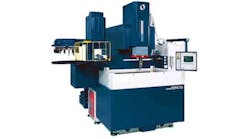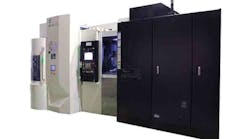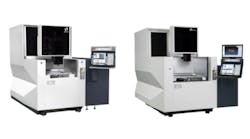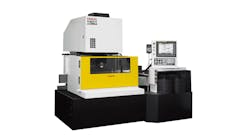Makino introduced a new Z-axis functionality for one of its electric-discharge machining systems, indicating it increases process speed, reduces electrode wear, and results in more uniform surface finishes for large-sinker EDM operations.
To reduce sinker EDM cycle times, the developer explained, it is not the maximum jump speed that is important but rather the acceleration speed. The new, HS-Rib high-speed Z-axis technology has a jump rate four times faster and Z-axis acceleration rate 30 times faster over previous technologies, Makino reported. This produces a more efficient hydraulic effect during machine, which helps to evacuate debris from the spark gap, “even in deep-rib features,” it said.
“As with all machining processes, there’s an insatiable desire to reduce cycle times while meeting part-quality requirements in sinker EDM processing,” according to EDM product manager Brian Pfluger,. “Fulfilling these needs involves a number of considerations, including how to process for best speed and efficiency, minimize electrode manufacturing requirements, and reduce electrode wear to achieve the best possible surface finish quality.”
Pfluger added that the HS-Rib Z-axis technology, combined with Makino’s SuperSpark IV, helps support those factors, establishing an efficient balance of electrode consumption and cycle times without the need for external auxiliary flushing.”
The new Z-axis technology is available on all Makino EDNC-Series sinker EDM machines, and is designed for use in large workpiece applications that call for high accuracy and fine surface finishes.
The EDNC-Series sinker EDM machines combine rigidity in construction with precision operation, along with programming simplicity and advanced performance for accuracy with large workpieces. Incorporating the new high-speed Z-axis technology makes it possible to machine deep ribs as fast as (or faster than, the smallest sinker EDM machines on the market. Automatic tool change and adaptive controls allow unattended machining, and advanced automatic jump machining controls optimize debris removal without the need for external flushing.
With HS-Rib high-speed Z-axis technology, EDNC-Series machines can achieve a jump rate of 20 m per minute with 1.5-G acceleration; Z-axis strokes ranging from 500 to 800 mm; and programming of orbital machining patterns with no amperage limitations. Using direct-drive motor technology and liquid cooling within the Z-axis structure ensures sustained thermal stability and precise depth control, and supports electrode weights of up to 100kg (220 lbs), Makino indicated.
Makino also offers four process strategies for optimal performance based on users’ unique requirements for speed, surface quality, accuracy and electrode wear:
• Low wear settings: Provides a single-electrode rough and finish process
• Advanced orbit and jump settings: Improves machining speeds and surface finish consistency;
• High-speed Z-axis: Improves machining speeds and accuracy; and
• Aggressive power settings: Optimizes machining speed (sacrifices electrode wear.)









